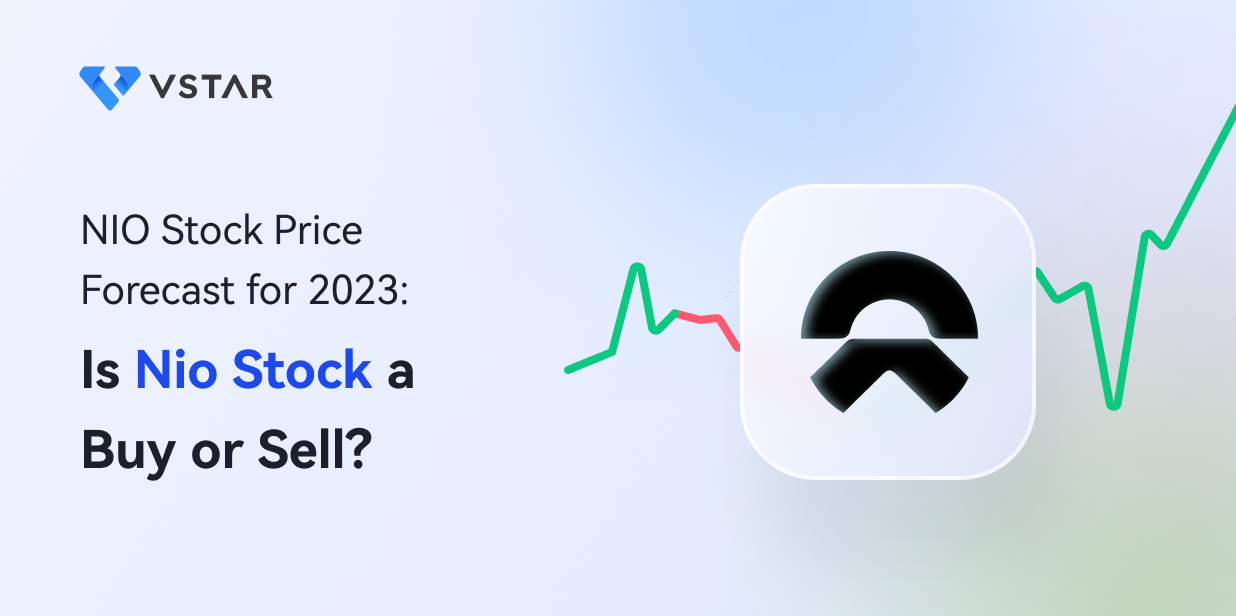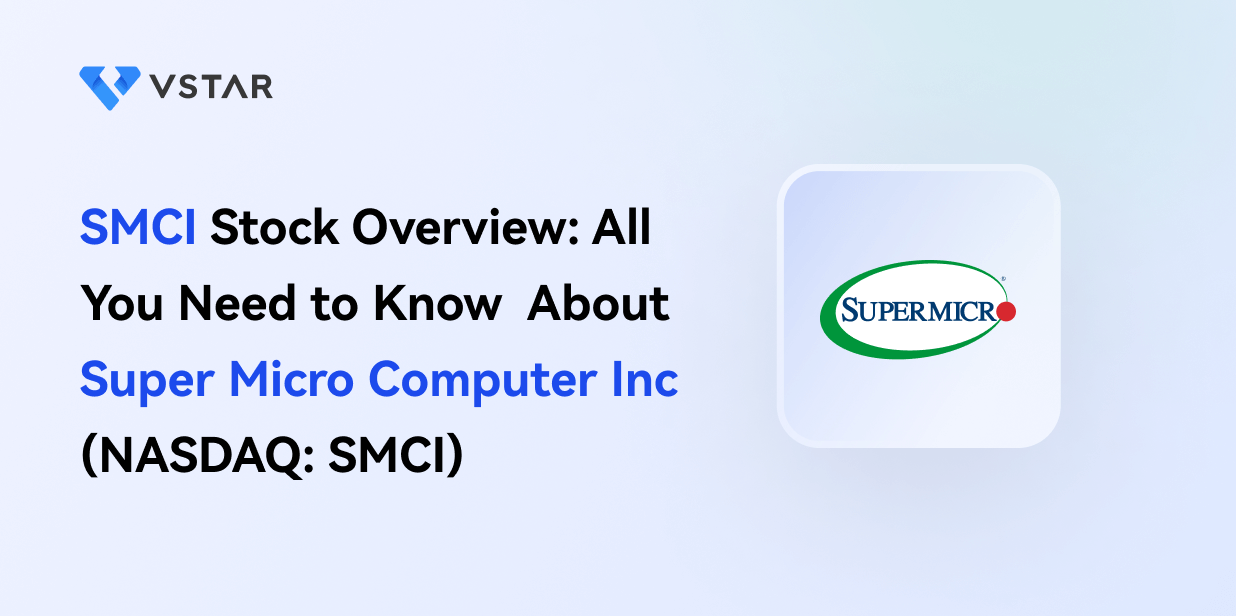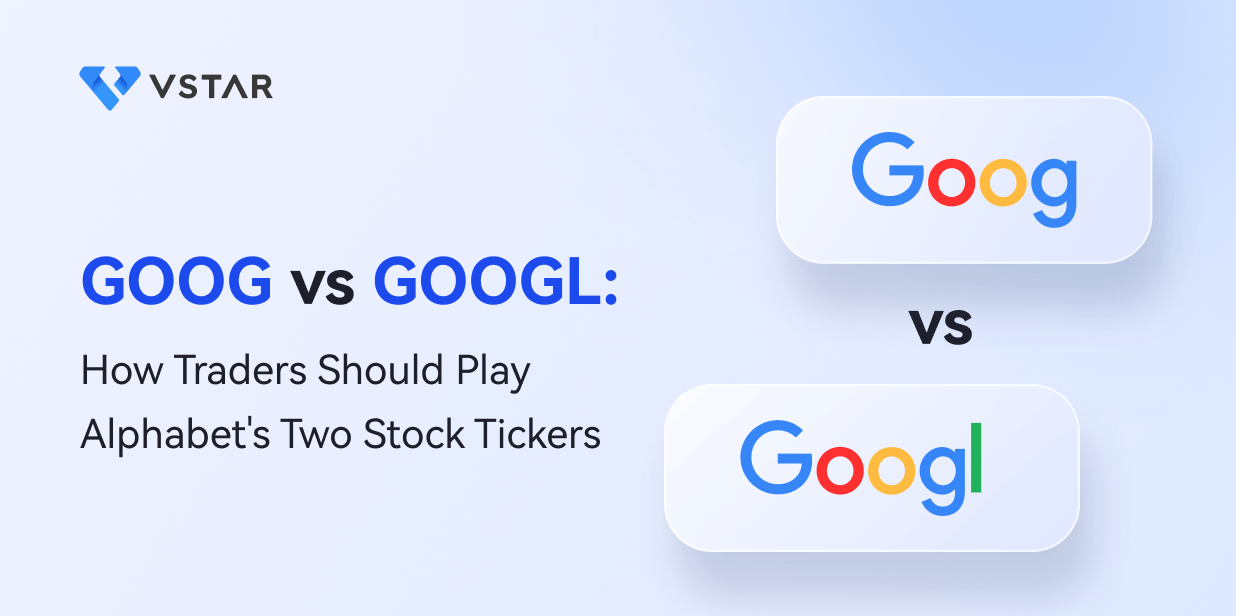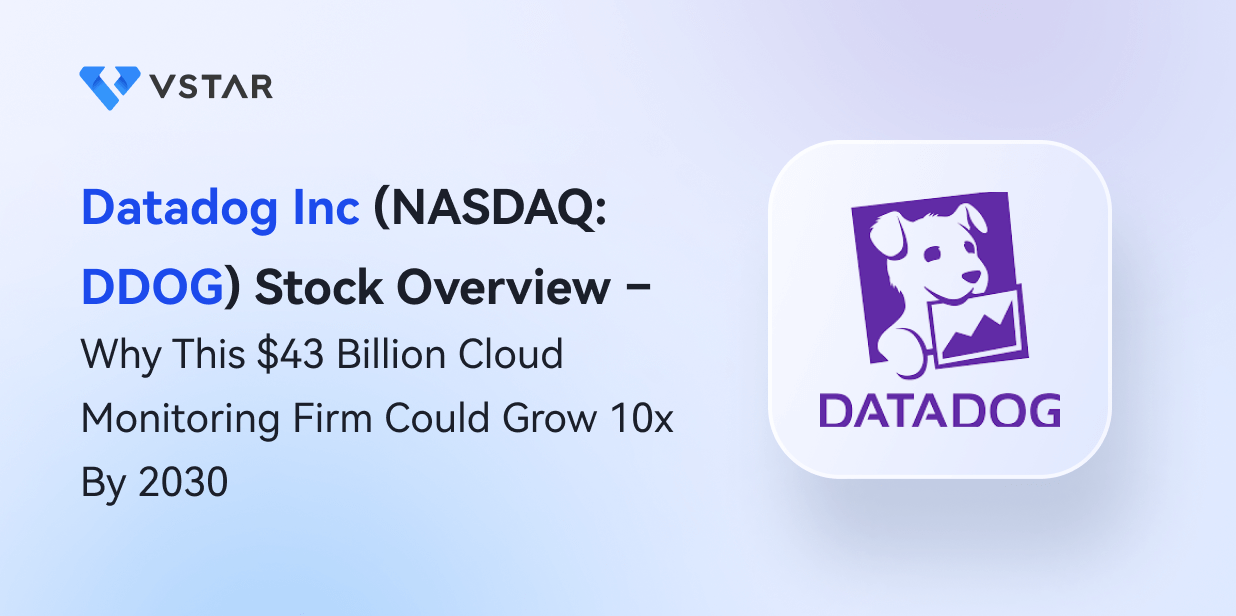It's no surprise that investors are interested in Nio stock, as the company is one of the leading players in the electric vehicle market. People are constantly watching the Nio stock news, analysis, and buy or sell recommendations, as well as Nio stock forecast, including Nio stock predictions for 2023. Many investors are also interested in learning how to invest in electric vehicle stocks, including Nio stock, as the industry continues to grow and evolve. Despite fierce competition from Tesla and other car manufacturers, Nio's strong brand, innovative technologies, and loyal customer base put it in a good position for future success. However, considering the electric vehicle market trends and EV market growth forecast goes a long way in helping you make the best investment judgments.
Overview of NIO Inc and NIO stock
Now, NIO Inc is a leading Chinese electric vehicle manufacturer that's revolutionizing the automotive industry. Since its founding in 2014, NIO has been on a mission to make high-performance EVs that not only meet but exceed customer expectations. And it's been successful in doing so, with its flagship NIO ES8 SUV and NIO ES6 five-seater SUV receiving critical acclaim and raving reviews from clients. NIO is also a tech company that's leading the way in developing innovative EV technologies such as battery swapping and autonomous driving systems.
And in just three years since its initial public offering on the New York Stock Exchange in 2018, NIO's stock has climbed sharply, with a market capitalization of over $60 billion. In 2020, NIO's stock price surged by over 1,000%, making it one of the hottest stocks of the year.
You see, the stock market can be turbulent, and being able to predict where a company's stock is headed is going to make all the difference in your investment strategy. So, what's next for NIO's stock price? Twenty-seven expert analysts have unveiled their 12-month price predictions for the illustrious NIO Inc. Their collective foresight has conjured up a median target of $12.31, with an optimistic high estimate of $25.04 and a pessimistic low estimate of $8.03. According to their calculations, if their median projection is correct, you could enjoy a significant upswing of 23.1% from NIO's current price of $10.0.

Now, NIO Inc. has set its sights on the booming market for electric vehicles, aiming to double its sales by 2023 with an expanded product lineup. However, NIO has been struggling financially, continuing to lose money despite its impressive sales growth. This has been reflected in its stock price, which has struggled over the past two years, which has triggered many to question whether NIO stock is a good buy.
But here's the kicker, while NIO may not be a buy at the moment, things could change quickly. NIO's sales are expected to improve dramatically with the introduction of several new EV models in 2023, which makes it a company you should keep on your radar.
A Review of NIO stock Performance for 2022
2022 has been an intriguing year for NIO Inc. As far as its financial position goes, the EV maker's current stock price and market capitalization have been a hot topic among investors, as the company's stock has seen significant ups and downs. But despite this volatility, NIO's revenue and earnings have been impressive, with the company continuing to outpace its competitors in the EV market.
But what about NIO's debt and liquidity position? This has only left investors breathing fire, as the company has taken on significant debt to fund its growth. However, NIO has been working to address the concern, and many analysts believe that the company is standing up strong when it comes to its debt and liquidity position.
There has been a lot happening in the world of electric vehicles over the past year. With more and more governments around the world pushing for a shift towards sustainable transportation, the EV market is only expected to grow in the coming years. And with NIO seen as a credible challenger to Tesla's dominance in the industry, many investors are excited about the company's potential for growth.
Of course, smaller investors have closely watched NIO stock's market response and its frontline investor sentiment over the past year. Despite some uncertainties along the way, the overall attitude towards NIO has remained largely positive.
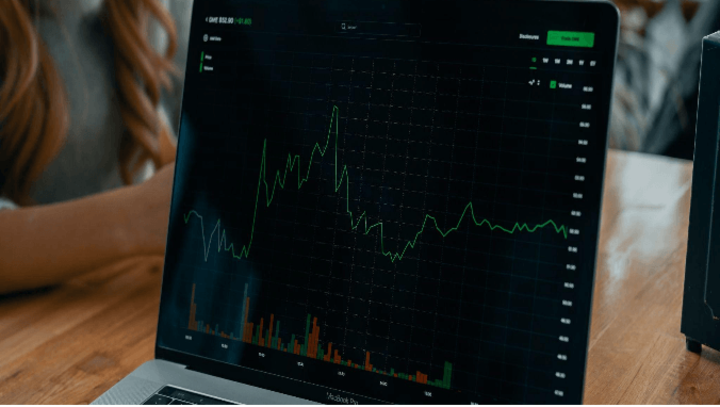
Key NIO stock metrics you should watch
A. Financial Performance
#1. Sales Revenue
NIO has experienced strong growth in sales revenue over the past few years. In 2022, NIO's vehicles raked in a margin of 13.7%, which, though not as high as the previous year's 20.1%, is still a reputable amount. Besides, the company generated US$7,143.3 million in total revenues, marking a strong 36.3% growth from the previous year.
#2. Revenue Growth
Now, some analysts expect NIO's revenue to continue growing at a rapid pace over the next few years. For 2023, the forecasted revenue growth rate is 84%, which is significantly higher than the average growth rate for the automotive industry as a whole.
#3. Gross Margin
NIO may have faced a slight dip in its vehicle and gross margin in 2022, but the company's founder and CEO, William Li, remains optimistic about its prospects. Li confidently stated that he expects Nio to reach a substantial gross margin of 18% to 20% by the end of 2023.
#4. Operating Margin
NIO's operating profit margin of -29.32% as of September 2022 may seem like a cause for alarm. But as a pioneer in China's EV market, NIO has been making significant strides in the industry, with its unique selling proposition of providing EVs at competitive prices.
One way NIO has been able to maintain its competitive edge is by leveraging the power of data. Through its cloud-based platform, NIO can collect data from its vehicles, charging stations, and other sources, allowing it to optimize its operations and better understand its customers' desires.
#5. Net Income
Despite recording negative net income figures for 2021 and 2022, the company's year-over-year increase in net income by 27.24% is a positive sign that NIO is moving toward profitability.
#6. Free Cash Flow
Nio had a total of $6.790 billion in cash as of September 30th, 2022. This figure reflects a 6.82% year-over-year decline, according to MacroTrends. But what does this really mean? Well, simply put, cash on hand refers to cash deposits that are immediately available for withdrawal from financial institutions, as well as short-term investments that can be quickly converted to cash equivalents. These are typically considered highly liquid and are reported with or near cash line items on financial statements.
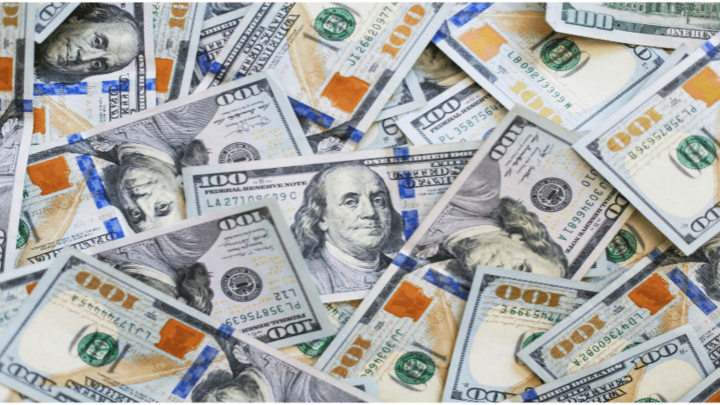
While a decline in cash on hand may seem concerning, it doesn't necessarily indicate financial instability. Companies may choose to use cash for a variety of reasons, such as investing in research and development, paying off debt, or acquiring other businesses. It's also possible that Nio may have chosen to invest its cash in longer-term, less liquid assets that aren't reflected in this figure.
#7. Earnings per Share (EPS)
Over the past 12 months, NIO's average revenue per share growth rate was an impressive 20.60% per year. This shows that NIO has been experiencing strong revenue growth, which can be attributed to its focus on innovation and affordability.
Looking at the past 3 years, NIO has maintained an average revenue per share growth rate of 18.60% per year. This indicates that the company's growth trajectory has been consistent and sustained over time.
#8. Price-to-Sales (P/S) Ratio
Looking at NIO's PS ratio over the years, we can see that it has fluctuated quite a bit. In 2018, when NIO went public, its PS ratio was around 16.5, which is much higher than the current ratio of 2.22. This indicates that investors were willing to pay a premium for NIO's stock, given its potential for growth in the electric vehicle market.
However, in 2019 and 2020, NIO's PS ratio dropped significantly, reaching a low of 0.9 in November 2020. This was due in part to the company's financial struggles, as it faced a liquidity crunch and had to seek government funding to stay afloat.
Since then, NIO's PS ratio has rebounded and has been steadily increasing, reaching 2.22 as of April 2023. This suggests that investors are once again optimistic about NIO's future growth prospects, and are willing to pay a premium for the company's stock.
So, how does NIO's PS ratio compare to the industry average? According to data from YCharts, the average PS ratio for companies in the automotive industry is currently around 0.92. This means that NIO's PS ratio of 2.22 is well above the industry average, indicating that investors are placing a higher value on NIO's growth potential compared to other companies in the industry.

#9. Price-to-Earnings (P/E) Ratio
Looking at NIO's P/E ratio over the years reveals some interesting trends. At the end of 2019, NIO's P/E ratio was -2.51, which means that the company was generating losses and had negative earnings per share. It gets worse. Over the next few years, NIO's P/E ratio has become even more negative, with the current ratio standing at -9.36424. This suggests that NIO's losses have increased over the past few years, making the company less attractive to investors.
Comparing NIO's P/E ratio to the industry average provides further insight into the company's valuation. As of 2023, the industry average P/E ratio for automotive companies is around 6. This is significantly higher than NIO's negative P/E ratio, indicating that investors are more bullish on other companies in the industry.
One reason for NIO's low P/E ratio is that the company has been investing heavily in research and development, marketing, and expanding its production capacity, which has led to significant losses in the short term. However, these investments could pay off in the long term if NIO captures a larger share of the Chinese EV market.
B. Vehicle Deliveries
NIO has demonstrated impressive growth in car deliveries over the years. In the first quarter of 2023, NIO delivered 31,041 vehicles, which is a significant increase of 20.5% year-over-year. This increase in deliveries suggests that NIO's innovative electric vehicles and efficient production strategies are resonating with consumers and contributing to the brand's steady growth.
A trend analysis of NIO's car deliveries reveals that the company has experienced remarkable growth since its inception. For instance, in 2019, NIO delivered a total of 20,565 vehicles, representing a year-over-year increase of 81.5%. In 2020, despite the COVID-19 pandemic, NIO delivered a total of 43,728 vehicles, representing a year-over-year increase of 113.8%.

Furthermore, NIO's cumulative deliveries of vehicles reached 320,597 as of March 31, 2023. The cumulative delivery numbers suggest that NIO is positioning itself as a strong contender in the global EV market, with the potential to rival other established EV brands.
C. Battery Technology Advancements
Nio's plans to start producing their own developed battery packs in 2024 is a significant milestone for the company as it marks a step towards further vertical integration in their supply chain. The decision to manufacture their own battery packs is likely driven by the need to improve the quality and reliability of their EVs, while also reducing costs and increasing efficiency.
One key benefit of producing their own battery packs is that Nio will have greater control over the quality of the batteries used in their EVs. This means that they will be able to ensure that their batteries are safe, reliable, and have a longer lifespan, which will help to increase customer satisfaction and loyalty. Additionally, by manufacturing its own battery packs, Nio will be able to reduce its reliance on third-party suppliers, which will help to improve its supply chain management and reduce costs. Overall, this should be good news for you as an investor.
D. International Expansion
Now, NIO's expansion into the German, Dutch, Danish, and Swedish markets marks a significant milestone in the company's global expansion strategy. The move is indicative of NIO's commitment to providing sustainable mobility solutions to consumers worldwide, and their recognition of the potential for growth in the European market.
The European market presents significant opportunities for NIO, particularly given the increasing demand for electric vehicles and the continent's commitment to reducing carbon emissions. Although the EV maker is looking to tap into the European market, it faces challenges in navigating complex regulations and cultural differences and establishing a strong distribution network. Furthermore, it is set to face increasing competition from well-established European electric vehicle manufacturers such as Volkswagen and BMW.
Key Risks and Challenges
● Supply chain disruptions
NIO has been facing supply chain disruptions due to the COVID-19 pandemic, which have resulted in shortages of key components such as semiconductors.
● Dependence on the Chinese market
NIO's success is largely dependent on the Chinese market, which accounted for over 95% of its total deliveries in the first quarter of 2021.
● Regulatory and policy hurdles
The Chinese government recently announced new regulations that require electric vehicle manufacturers to meet certain energy density requirements for their batteries.
● Increasing competition
NIO faces increasing competition from other electric vehicle manufacturers such as BYD, Tesla, and Xpeng. General Motors and Ford are also ramping up their electric vehicle production in China and other nations.
Expectations of NIO Stock for 2023
NIO's Financial Performance Forecast
According to the latest long-term forecast, NIO's stock price is set to experience an impressive upward trend in the coming years. Starting in 2023 at $9.75, the price of NIO's stock is expected to reach $10 by the middle of the year and $11.96 by the end of the year, representing a year-to-year change of 23%. However, the price of NIO's stock has experienced a 15% decrease from the beginning of the year to today's price of $8.33.
NIO expects its profit margin to continue climbing in 2023. The electric car giant expects to bring in between $1,584 million and $1,674 million in total revenues, marking a significant jump of 10.2% to 16.5% compared to the same quarter last year.
As of 23rd of April 2023, NIO's Net Cash Flow from Operations is predicted to flourish, reaching an astounding 2.4 B. But on the flip side, the Free Cash Flow is likely to dwindle by 2.6. NIO's financial fate hangs in the balance, and its financial forecast is subject to change.
Market Share Projection
NIO Inc is aiming to achieve its target of 250,000 vehicles by the end of 2023. However, this ambitious target relies heavily on the success of the NT2.0 platform shift and the launch of multiple new products in a short period. The EV maker has struggled with over-promising and under-delivering in the past, and this has been a concern for investors.
To achieve the target, NIO will need to quickly increase monthly deliveries to new highs, which will require production capacity to expand to 25,000 to 35,000 units per month by Q3 through Q4. April will be a crucial month for NIO, as deliveries need to move back to the 14,000 unit range to put the company on track toward the 250,000 vehicle target.
And that's not all. On March 28, NIO announced a new partnership with Tibber, an energy technology company. With this groundbreaking collaboration, NIO's customers will be able to tap into the power of real-time data and track their energy usage like never before. Plus, they'll have the ability to control the charging of their electric cars, optimizing their energy consumption during peak and off-peak hours.
And it doesn't stop there. As NIO charges full speed ahead towards its ambitious goal of adding 1,000 battery swap stations and 10,000 charging piles by 2023, the electric car maker is turning to its trusted partners for support.
Technical Analysis
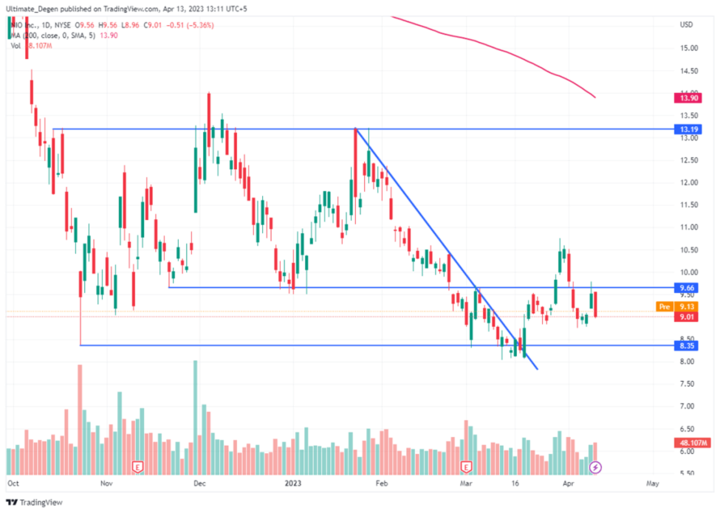
What you're seeing above is a chart for the NIO stock trend from October 2022.
The vertical axis on the left-hand side of the chart shows the price of NIO shares in USD. The horizontal axis along the bottom shows the date range for the chart.
The chart includes candlesticks, which are a type of chart used in technical analysis to show the price movements of an asset over time. Each candlestick represents the opening, closing, high, and low prices for a given period (in this case, daily candlesticks). We'll discuss the candlestick shapes and patterns represented in the chart shortly.
The chart also includes horizontal lines to represent key price levels. In this case, the chart shows the $9.6 resistance level and the $8.35 support level. Finally, the chart includes a volume histogram at the bottom, which shows the number of shares traded each day. Higher volume can be an indication of increased buying or selling pressure and can provide insight into the strength of a trend.
The NIO chart unveils some interesting support and resistance levels that have dictated the stock's behavior in the past. Among these levels, two are particularly noteworthy: the $9.6 resistance and the $8.35 support. Although NIO recently broke above $10, it failed to hold its ground and rally past the psychological barrier.
Looking ahead, NIO shares could experience a downward correction from their current position. However, if they can manage to recapture the $10 level, the next major objective will be the $13.20 resistance, which represents the high point reached in January 2023. On the other hand, if the stock falls below its April low of $8.75, it may revisit the $8.35 support level, testing its resilience once more.
Now, NIO's market movement is represented in the chart by candlesticks. Here are some observations we made from the candlestick shapes and patterns:
Starting from the left side of the chart, we can see that NIO was in a downtrend from early March until mid-March. This is indicated by the red candlesticks with long wicks, which suggest that the stock was unable to maintain higher prices due to the selling pressure.
On March 18th, we can see a bullish reversal pattern called a "hammer" candlestick. This pattern is characterized by a small body and long lower wick, indicating that the stock opened near its low price for the day but then rallied strongly to close near its high. This is a sign that buying pressure is starting to outweigh selling pressure, and can be a bullish signal for traders.
Following the hammer candlestick, NIO experienced a period of consolidation with small green and red candlesticks, indicating that the stock was trading within a relatively narrow range.
On April 6th, we see another bullish reversal pattern called a "bullish engulfing" candlestick. This pattern is characterized by a green candlestick that "engulfs" the previous day's red candlestick and can be a sign that buyers have taken control and the stock is likely to continue rising.
After the bullish engulfing candlestick, NIO rallied strongly and broke above the $10 resistance level. However, we can see that the stock was unable to hold above this level, and the subsequent candlesticks are mostly red with long upper wicks, indicating that the stock was experiencing selling pressure and was unable to maintain higher prices.
Finally, on April 13th, we see a bearish reversal pattern called a "shooting star" candlestick. This pattern is characterized by a small green body with a long upper wick, indicating that the stock opened near its low price for the day but then experienced selling pressure and closed near its low. This is a sign that selling pressure is starting to outweigh buying pressure, and can be a bearish signal for traders.
The candlestick patterns on this chart suggest that NIO has been experiencing some volatility, but with some bullish and bearish signals mixed in. You may be watching for further confirmation of a trend and paying attention to key support and resistance levels like $10 and $8.35.
Nio Stock Forecast 2024
NIO stock has fallen significantly from its 2021 highs and currently trades around $7. NIO aims to increase deliveries from 122,000 vehicles in 2022 to over 600,000 annually in the next few years by expanding production capacity and model offerings. If NIO can achieve strong growth in the large Chinese EV market, gain market share from rivals such as BYD and Xpeng, and continue to receive government support, the stock could potentially recover to its historical valuation. However, near-term headwinds such as supply chain issues and China's economic slowdown cloud the 2024 outlook. Unless growth reaccelerates more than expected, analysts see limited upside for Nio, with most 2024 price targets clustered in the $10-$15 range. Execution risks remain, but China's EV adoption trends still favor the long-term growth story.
Is NIO a good stock to buy?
If we consider NIO's competitive advantages in the electric vehicle industry, a promising investment opportunity begins to take shape. NIO's innovative technology, featuring the NOMI personal assistant, offers a truly futuristic driving experience that sets it apart from its competitors. The company's strong brand identity, highlighting its Chinese heritage and sustainability efforts, fosters customer loyalty and attracts environmentally conscious buyers.
It gets better. You see, NIO has the power to scale up production quickly to meet the growing demand for electric vehicles because it has its own manufacturing capabilities. Besides, the company's unique service and support offerings, such as mobile charging vans and valet service, provide unparalleled convenience to NIO owners. When we combine these strengths with NIO's favorable financial metrics, it becomes clear that this is a stock worth considering to buy.
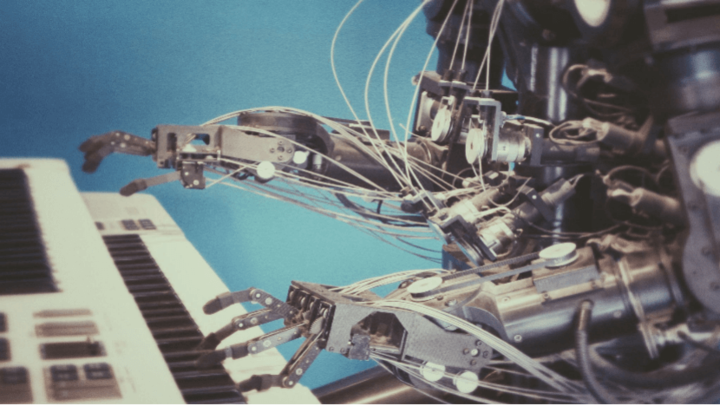
What are the ways to trade NIO stock?
Hold its share
One way to trade NIO stock is simply to buy and hold its shares. This involves purchasing NIO shares on a stock exchange and holding them for an extended period. The goal is to sell the shares at a higher price than what was paid for them, making a profit in the process.
Let's say you bought 100 shares of NIO at $10 per share, investing a total of $1,000. If NIO's stock price increases to $20 per share, your investment is now worth $2,000, and you've made a profit of $1,000.
Trading options
Another way to trade NIO stock is through options. An option is a contract that gives the holder the right, but not the obligation, to buy or sell a stock at a specific price within a certain timeframe. Options can be used to profit from both rising and falling stock prices.
Let's say you purchased a call option on NIO with a strike price of $50 and an expiration date of three months from now. The premium (the price of the option) is $5 per share. If NIO's stock price increases to $60 per share by the expiration date, you can exercise the option and buy 100 shares of NIO at the strike price of $50 per share, for a total cost of $5,000. You can then sell the shares for a total of $6,000, making a profit of $1,000. If NIO's stock price does not rise above the strike price, you can let the option expire and only lose the premium paid.
CFDs
A third way to trade NIO stock is through CFD (Contract for Difference) trading. CFDs are financial derivatives that allow traders to speculate on the price movements of an asset without actually owning the asset. CFD trading can offer several advantages over traditional stock trading, such as leverage and the ability to short-sell.
Let's say you enter a long position on NIO CFDs with a leverage of 10:1. You invest $1,000, but because of the leverage, your position is worth $10,000. If NIO's stock price increases by 10%, your position is now worth $11,000, and you've made a profit of $1,000. However, if NIO's stock price decreases by 10%, your position is now worth $9,000, and you've lost $1,000. Beware that leverage can amplify both profits and losses in CFD trading.
When it comes to CFD trading vs. traditional stock trading, there are several differences to consider. One key difference is ownership - with CFD trading, you do not own the underlying asset, whereas, with traditional stock trading, you do. Additionally, CFD trading allows for leverage, which can increase potential profits but also comes with increased risk. CFD trading also allows for short-selling, which can allow traders to profit from falling stock prices.
VSTAR is one option to consider trading NIO stock CFDs
VSTAR is a regulated broker that offers CFD trading on a variety of assets, including NIO stock. Let's say you decide to trade NIO CFDs with VSTAR and enter a long position with a leverage of 10:1. You invest $1,000, but because of the leverage, your position is worth $10,000. If NIO's stock price increases by 10%, your position is now worth $11,000, and you've made a profit of $1,000. VSTAR offers competitive spreads, which can help reduce your trading costs. Also, its user-friendly trading platform allows for easy access to trading tools and market analysis. VSTAR offers educational resources as well as customer support.
Conclusion
NIO continues to make weighty strides in the EV market, thanks to its innovative technologies, strong brand, and loyal customer base. Despite fierce competition from Tesla, BYD, and other car manufacturers, NIO's prospects are promising, with the introduction of several new EV models in 2023. While NIO's financial struggles may deter some investors, the company's revenue and earnings have been impressive, and its stock price has the potential to rise significantly in the future. But before investing in NIO, you always want to consider the factors that can impact its stock price, such as global demand for EVs, government policies, and competition from other companies. Ultimately, whether or not to invest in NIO stock depends on your risk tolerance and investment strategy.
